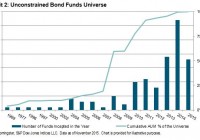Pain Or Gain Ahead For Bank ETFs?
The going has been tough for bank ETFs for quite some time now mainly due to the twin attacks of a delay in further Fed rate hikes after a liftoff in December and the energy sector lull. Moreover, UBS Group AG’s (NYSE: UBS ) moderate earnings for the fourth quarter of 2015 triggered a sell-off in banking stocks because the bank pointed to several macroeconomic headwinds and geopolitical issues that will bother its operations in the near term. Not only banking stocks, broad-based risk-on sentiments took a backseat in the first quarter of 2016. Now, with the earnings season impending and the broader markets rebounding, albeit slowly, let’s catch a glimpse of the looming headwinds and tailwinds to the banking sector. Headwinds Tightening Yields: The benchmark U.S. 10-year Treasury note yield slipped to 1.76% on April 6, 2016 (down 48 since the start of the year) while the yield on the short-term Treasury note (one year of maturity) fell to 0.55% on the same day (down just 6 bps since the beginning of 2016). The narrowing gap between the short and long-term yields has been a cause of concern for the backing sector (read: Bank ETFs Hurt by the Dovish Fed ). In fact, in early March, the spread between the two-year and 10-year Treasury yields tapered the most since 2009. Narrowing spread between long- and short-term rates hurts net interest margin, which a key metric for the banking sector. Energy Sector Exposure: U.S. banks have significant exposure to the long-ailing energy sector where chances of credit default are higher. In February, the S&P cut its outlook on several regional banks with the highest energy sector exposure citing a likely increase in non-performing assets. Among the biggies, Wells Fargo (NYSE: WFC ) reported around $42 billion oil and gas credit in February. The situation is the same for JPMorgan (NYSE: JPM ), the energy loan of which accounts for 57% of the investment-grade paper. JPMorgan has ‘ set aside $600 million’ for loan losses emanating from the energy, metals and mining sectors. Panama Papers Scandal: The leaked documents from Panama Law firm Mossack Fonseca & Co. revealing global business leaders and officials moving money to international tax havens may take a toll on bank stocks. Banks may now face more stringent scrutiny and litigation issues to arrest means of evading taxes. Tailwinds Increased Activity: Having described the stress situation, we would like to note that fears of a 2008-like recession or financial market crash are perhaps exaggerated. The lower interest rates should boost capital market activities and benefit banks in other ways. After all, bank stocks have gained their lost ground in the U.S. in a rock-bottom interest rate environment (see all Financials ETFs here). Compelling Valuation: The finance sector has a current-year P/E of 12.6 times, reflecting a 27.6% discount to the S&P while its next-year P/E stands at 11.5 times, reflecting a 25.3% discount to the S&P 500. Such an intriguing valuation might also help the sector to score gains as and when favorable industry dynamics hit the space. ETF Impact All in all, bank stocks are on the fence with pain and gain on either side, though downside risks look higher at the current level. So, investors seeking a financial sector exposure can have a look at the following ETFs: The PowerShares KBW Bank Portfolio ETF (NYSEARCA: KBWB ) , with considerable exposure to Wells Fargo, JPMorgan and US Bancorp (NYSE: USB ). The fund has a Zacks ETF Rank #3 (Hold) with a High risk outlook. SPDR S&P Bank ETF (NYSEARCA: KBE ) also has similar holdings; but it holds stocks in an equal-weighted manner. No stock accounts for more than 2.19% of the fund and diversifies stock-specific risks pretty well. KBE has a Zacks ETF Rank #3 with a High risk outlook. SPDR S&P Regional Banking ETF (NYSEARCA: KRE ) takes into account companies that do business as regional banks or thrifts. KRE also has a Zacks ETF Rank #3. iShares MSCI Europe Financials Sector Index ETF (NASDAQ: EUFN ) measures the combined equity market performance of the financial sector of developed market countries in Europe. The fund has a Zacks ETF Rank #3. Link to the original post on Zacks.com
